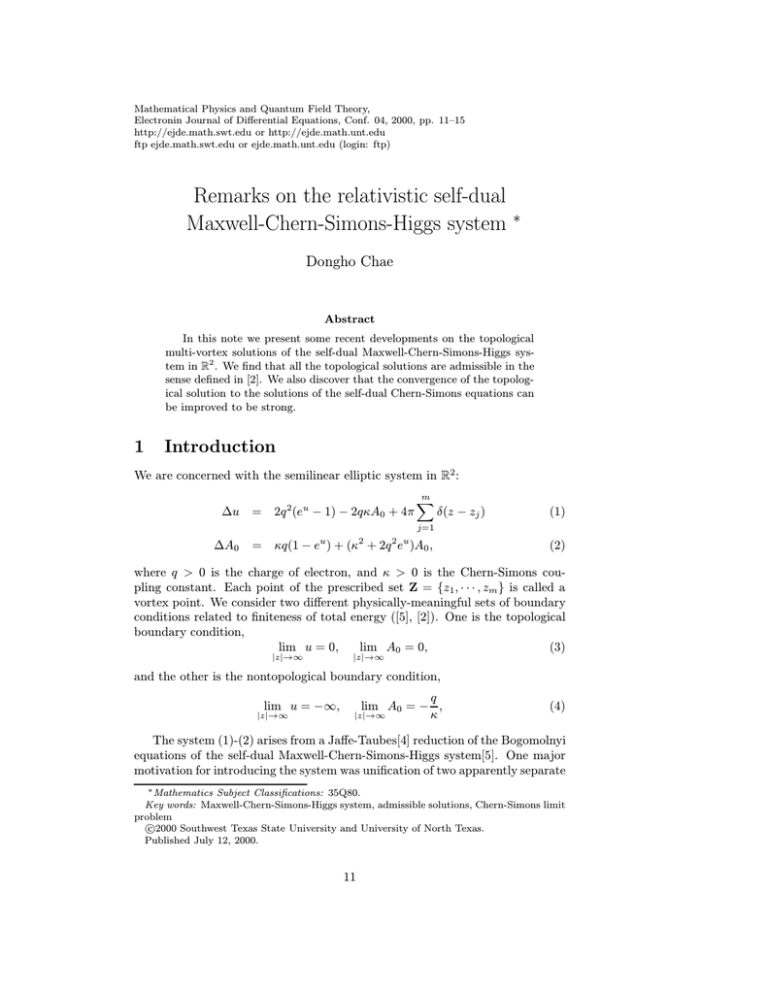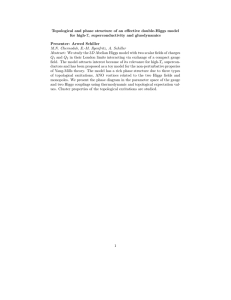Document 10773301
advertisement

Mathematical Physics and Quantum Field Theory,
Electronin Journal of Differential Equations, Conf. 04, 2000, pp. 11–15
http://ejde.math.swt.edu or http://ejde.math.unt.edu
ftp ejde.math.swt.edu or ejde.math.unt.edu (login: ftp)
Remarks on the relativistic self-dual
Maxwell-Chern-Simons-Higgs system
∗
Dongho Chae
Abstract
In this note we present some recent developments on the topological
multi-vortex solutions of the self-dual Maxwell-Chern-Simons-Higgs system in R2 . We find that all the topological solutions are admissible in the
sense defined in [2]. We also discover that the convergence of the topological solution to the solutions of the self-dual Chern-Simons equations can
be improved to be strong.
1
Introduction
We are concerned with the semilinear elliptic system in R2 :
∆u
=
2q 2 (eu − 1) − 2qκA0 + 4π
m
X
δ(z − zj )
(1)
j=1
∆A0
=
κq(1 − eu ) + (κ2 + 2q 2 eu )A0 ,
(2)
where q > 0 is the charge of electron, and κ > 0 is the Chern-Simons coupling constant. Each point of the prescribed set Z = {z1 , · · · , zm } is called a
vortex point. We consider two different physically-meaningful sets of boundary
conditions related to finiteness of total energy ([5], [2]). One is the topological
boundary condition,
lim A0 = 0,
(3)
lim u = 0,
|z|→∞
|z|→∞
and the other is the nontopological boundary condition,
lim u = −∞,
|z|→∞
q
lim A0 = − ,
κ
|z|→∞
(4)
The system (1)-(2) arises from a Jaffe-Taubes[4] reduction of the Bogomolnyi
equations of the self-dual Maxwell-Chern-Simons-Higgs system[5]. One major
motivation for introducing the system was unification of two apparently separate
∗ Mathematics Subject Classifications: 35Q80.
Key words: Maxwell-Chern-Simons-Higgs system, admissible solutions, Chern-Simons limit
problem
c
2000
Southwest Texas State University and University of North Texas.
Published July 12, 2000.
11
Maxwell-Chern-Simons-Higgs system
12
systems, namely, the Abelian Higgs system and the Chern-Simons system. The
Abelian Higgs system reduces to
∆u = 2q 2 (eu − 1) + 4π
m
X
δ(z − zj ),
(5)
j=1
while the Chern-Simons system reduces to
∆u = 4l2 eu (eu − 1) + 4π
m
X
δ(z − zj ),
(6)
j=1
where l is a physical parameter related to the Chern-Simons constant. The
Abelian Higgs system (5) has finite-energy solutions under only the topological
boundary conditions (3), while the Chern-Simons system has finite-energy solutions under either boundary conditions (3) or (4). For the precise meaning of
the finite energy of these systems, we refer to [4].
The mathematical analysis of the topological multi-vortex solutions for the
Abelian Higgs system and the Chern-Simons system is studied in [4] and [7],
[6]. We note that recently existence of non-topological multi-vortex solutions
of (6) is established in [1]. The existence of topological multi-vortex solutions
of (1)-(2) was established by a simple variational argument in [2]. Moreover,
the existence of so-called admissible solutions was established by an iteration
scheme in [2]. We recall the definition of admissible topological solution of (1)(3).
Definition A topological solution pair (u, A0 ) of (1)-(2) is called admissible
if it satisfies one of the following inequalities.
(i) A0 ≤ 0
(ii) u ≤ 0
(iii) A0 ≥ κq (eu − 1)
(iv) v ≤ uqa , where uqa is the solution the (topological) Abelian Higgs equation
(5).
We remark that the conditions (i)-(iv) are shown to be equivalent to each
other[2]. In [2] we also considered the two convergence problems of the admissible topological solutions of (1)-(2) . One is the Abelian Higgs limit, namely the
problem of identifying the behavior of the solution uκ,q of (1)-(2) as κ → 0 with
q kept fixed. The other is the Chern-Simons limit, the similar problem as both κ
and q go to infinity with the ratio l = q 2 /κ kept fixed. In the Abelian Higgs limit
we proved in [2] that admissible topological solution of (1)-(2) converges strongly
to the solution of the Abelian Higgs solution, while in the Chern-Simons limit
we could just show that our solution is weakly consistent to the Chern-Simons
equation. For the precise statements of these results see [2]. The natural open
questions raised were
Dongho Chae
13
1. Is any topological solution of (1)-(2) , which is smooth except at the points
z1 , · · · , zm , admissible?
2. Can we strengthen the sense of convergence in the Chern-Simons limit
problem?
Question 1 is concerned with the physical validity of the model system, (1)-(2),
since u ≤ 0 is equivalent to the condition |φ|2 = eu ≤ 1 for the Higgs field φ.
Question 2, combined with the already established strong convergence in the
Abelian Higgs limit, is concerned with the rigorous verification of the physical
argument that the Maxwell-Chern-Simons-Higgs model is a unification of the
Abelian Higgs model and the Chern-Simons model[5]. In [3] we answer these
two questions in the affirmative. In the next section we state our results and
their implications.
For further discussion, we introduce the background function u0 defined by
u0 =
m
X
ln
j=1
|z − zj |2
1 + |z − zj |2
,
and we set u = v + u0 to remove the singular inhomogeneous term in (1). Then
(1) and (2) become
∆v
∆A0
= 2q 2 (ev+u0 − 1) − 2qκA0 + g,
= κq(1 − e
v+u0
2
2 v+u0
) + (κ + 2q e
(7)
)A0
(8)
with the topological boundary condition
lim v = 0,
|z|→∞
where
g=
m
X
j=1
lim A0 = 0,
|z|→∞
(9)
4
.
(1 + |z − zj |2 )2
In this setting the Chern-Simons equation (6) becomes
∆v = 4l2 ev+u0 (ev+u0 − 1) + g.
2
(10)
Main Results
The following result is proved in [3].
Theorem 1 Suppose Z = {z1 , · · · , zm } ⊂ R2 is given as before. Then any
topological solution (u, A0 ) in C 2 (R2 \ Z) is admissible.
One immediate consequence of Theorem 1 and the argument of the construction
is that the solution constructed in Section 3 is maximal. On the other hand,
Maxwell-Chern-Simons-Higgs system
14
due to the monotonicity of the minimizing functional F,
Z 1
|∆v|2 − (∆g − κ2 g)v + 2q 4 (ev+u0 − 1)2
F (v) =
2
1
+ κ2 |∇v|2 + 2q 2 ev+u0 |∇(v + u0 )|2 dx,
2
(11)
as established in Section 4 of [2], the solution constructed in Section 2 of [2]
by the variational method is minimal. Thus we have, as a result, constructed
the maximal and the minimal solutions of the system. As remarked in [3], the
strong convergence in the Chern-Simons limit for admissible solutions in the
periodic boundary condition can be extended to the case of our solutions of the
system (7)-(8). In particular, due to Theorem 1 we can remove the condition of
admissibility, and obtain:
κ,q
Theorem 2 Let (v κ,q , Aκ,q
→
0 ) be any topological solution of (7)-(8). Then v
2
l
q
κ κ,q
l
vcs +u0
1
2
vcs , and q A0 → e
− 1, both in H (R ) as κ → ∞ with κ = l kept fixed,
l
where vcs
denotes a topological solution of (10).
We now have further open problems to consider for the system (1)- (2):
1. Prove uniqueness, or multiplicity of topological solution.
2. Prove existence of non-topological multi-vortex solutions.
Acknowledgements. The author would like to thank Prof. J. Jang for helpful discussions on topics issued in this note. This research is supported partially by KOSEF(K97070202013), BSRI-MOE, GARC-KOSEF and SNU Research Fund.
References
[1] D. Chae and O. Yu. Imanuvilov, The existence of non- topological multivortex solutions in the relativistic self-dual Chern-Simons theory, IMA
Preprint Series 1629, (1999).
[2] D. Chae and N. Kim, Topological multi-vortex solutions of the self-dual
Maxwell-Chern-Simons-Higgs system , J. Differential Equations 134 , no.
1, pp. 154–182(1997).
[3] D. Chae and N. Kim, Vortex condensates in the relativistic self-dual MaxwellChern-Simons-Higgs system, RIM-GARC Preprint Series 97-50, (1997).
[4] A. Jaffe and C. Taubes, Vortices and Monopoles, Birkhäuser, Boston, (1980).
[5] C. Lee, K. Lee and H. Min, Self-Dual Maxwell Chern-Simons Solitons, Phys.
Lett. B, 252, pp. 79-83(1990).
Dongho Chae
15
[6] J. Spruck and Y. Yang, Topological Solutions in the Self-Dual Chern-Simons
Theory: Existence and Approximation, Ann. Inst. Henri Poincaré, 12, pp.
75-97(1995).
[7] R. Wang, The Existence of Chern-Simons Vortices, Comm. Math. Phys.,
137, pp. 587-597(1991).
Dongho Chae
Department of Mathematics
Seoul National University
Seoul 151-742, Korea
e-mail: dhchae@math.snu.ac.kr




